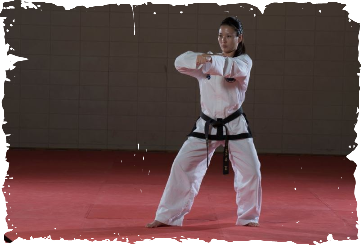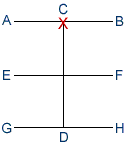Black Belt Patterns and Videos
Below you will find videos of each of the Black Belt Patterns from 1st Degree to 6th Degree. There are a total of 24 patterns in Taekwon-Do, as created by our Founder General Choi Hong Hi. Remember, these videos are a guide only and are there to assist you in learning your patterns. If you are unsure of any particular technique, remember that your instructor is your first point of call.
Kwang-Gae Tul 광개
KWANG-GAE is named after the famous Kwang-Gae-Toh-Wang, the 19th King of the Koguryo Dynasty, who regained all the lost territories including the greater part of Manchuria. The diagram represents the expansion and recovery of lost territory. The 39 movements refer to the first two figures of 391 A. D, the year he came to the throne.


Po-Eun Tul 포은
PO-EUN is the pseudonym of a loyal subject Chong Mong-Chu (1400) who was a famous poet and whose poem "I would not serve a second master though I might be crucified a hundred times" is known to every Korean. He was also a pioneer in the field of physics. The diagram represents his unerring loyalty to the king and country towards the end of the
Koryo Dynasty (36 movements).
Koryo Dynasty (36 movements).


Ge-Baek Tul 계백
GAE-BAEK is named after Gae-Baek, a great general in the Baek Je Dynasty (660 AD). The diagram represents his severe and strict military discipline (44 movements).


Eui-Am Tul 의암
EUI- AM is the pseudonym of Son Byong Hi, leader of the Korean independence movement on March 1, 1919. The 45 movements refer to his age when he changed the name of Dong Hak (Oriental culture) to Chondo Kyo (Heavenly way religion) in 1905. The diagram represents his Indomitable Spirit, displayed while dedicating himself to the prosperity of
his nation.
his nation.


Choong-Jang Tul 충장
CHOONG-JANG is the pseudonym given to General Kim Duk Ryang who lived during the Lee Dynasty, 14th century. This pattern ends with a left-hand attack to symbolize the tragedy of his death at 27 in prison before he was able to reach full maturity (52 movements).


Juche Tul 주체
JUCHE is a philosophical idea that man is the master of everything and decides everything. In other words, the idea that man is the master of the world and his own destiny. It is said that this idea was rooted in Baekdu Mountain which symbolizes the spirit of the Korean people. The diagram represents Baekdu mountain (45 movements).


Ko-Dang Tul 고당
This was the pattern that General Choi replaced with Juche. It can now be performed as an optional pattern to Juche for those over 40 years of age.
Kodang is the Pseudonym of the patriot Cho Man Shik, who dedicated his life to the Korean Independence Movement and to the education of his people. The 45 movements represent the last two figures of 1945, the year Korea was liberated from Japanese occupation.
Kodang is the Pseudonym of the patriot Cho Man Shik, who dedicated his life to the Korean Independence Movement and to the education of his people. The 45 movements represent the last two figures of 1945, the year Korea was liberated from Japanese occupation.

Sam-Il Tul삼일
SAM-IL denotes the historical date of the independence movement of Korea which began throughout the country on March 1, 1919. The 33 movements in the pattern stand for the 33 patriots who planned the movement.


Yoo-Sin Tul 유신
YOO-SIN is named after General Kim Yoo Sin, a commanding general during the Silla Dynasty. The 68 movements refer to the last two figures of 668 A.D., the year Korea was united. The ready posture signifies a sword drawn on the right rather than left side, symbolizing Yoo-Sin's mistake of following his Kings' orders to fight with foreign forces against his own nation.


Choi-Yong Tul 최영
CHOI-YONG is named after General Choi Yong, premier and commander in chief of the armed forces during the 14th century Koryo Dynasty. Choi Yong was greatly respected for his loyalty, patriotism, and humility. He was executed by his subordinate commanders headed by General Yi Sung Gae, who later became the first King of the Lee Dynasty (46 movements).


Yong-Gae Tul 연개
YONG-GAE is named after a famous general during the Koguryo Dynasty, Yon Gae Somoon. The 49 movements refer to the last two figures of 649 A.D., the year he forced the Tang Dynasty to quit Korea after destroying nearly 300,000 of their troops at Ansi Sung.


Ul-Ji Tul 을지
UL- JI is named after general Ul-Ji Moon Dok who successfully defended Korea against a Tang's invasion force of nearly one million soldiers led by Yang Je in 612 A.D., Ul-Ji employing hit and run guerilla tactics, was able to decimate a large percentage of the force. The diagram represents his surname. The 42 movements represent the author's age when
he designed the pattern.
he designed the pattern.


Moon-Moo Tul 문무
Moon-Moo honours the 30th King of the Silla Dynasty. His body was buried near Dae Wang Am (Great King's Rock). According to his will, the body was placed in the sea "where my soul shall forever defend my land against the Japanese." It is said that the Sok Gul Am (Stone cave) was built to guard his tomb. The Sok Gul Am is a fine example of the culture of the Silla Dynasty. The 61 movements in this pattern symbolize the last two figures of 661 A.D. when Moon-Moo came to the throne.


So-San Tul 서산
SO-SAN is the pseudonym of the great monk Choi Hyong Ung (1520-1604) during the Lee Dynasty. The 72 movements refer to his age when he organized a corps of monk soldiers with the assistance of his pupil Sa Myunh Dang. The monk soldiers helped repulse the Japanese pirates who overran most of the Korean Penninsula in 1592.


Se-Jong Tul 세종
SE-JONG is named after the greatest Korean King, Se-Jong, who invented the Korean alphabet in 1443, and was also a noted meteorologist. The digram represents the king, while the 24 movements refer to the 24 letters of the Korean alphabet


Tong-Il Tul 통일
TONG-IL denotes the resolution of the unification of Korea which has been divided since 1945. The diagram symbolizes the homogenous race (56 movements).




